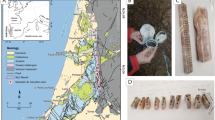Abstract
THE helium method of measuring geological time, originally devised by Lord Rayleigh, has hitherto been applied only to minerals or other materials that were found to be relatively rich in the radioactive elements, uranium and/or thorium. It is already well known that the results obtained are to be regarded as minima, on account of the special tendency of accumulated helium to escape from such specimens during their exposure to the atmosphere and during their preparation for analysis. This tendency is necessarily most marked in old and richly radioactive minerals, like uraninite and thorianite, in which large quantities of helium have been generated (for example, 10 c.c. per gm.). In very feebly radioactive materials, like ordinary igneous rocks, the amount of helium is correspondingly minute (for example, about 10-4 to 10-5c.c. per gm.), and its proportion to that of other gases (about 1 c.c. per gm.) is very low. The ordinary gases of an igneous rock are not appreciably extractable by a pump, even when specimens are ground in vacuo; nor, as a rule, do they begin to escape in appreciable quantity as a result of heating, until the temperature exceeds 300° C. It is therefore to be anticipated that the loss of helium from specimens of close-grained igneous rocks awaiting analysis will be much less serious than that from radioactive minerals.
This is a preview of subscription content, access via your institution
Access options
Subscribe to this journal
Receive 51 print issues and online access
$199.00 per year
only $3.90 per issue
Buy this article
- Purchase on Springer Link
- Instant access to full article PDF
Prices may be subject to local taxes which are calculated during checkout
Similar content being viewed by others
Author information
Authors and Affiliations
Rights and permissions
About this article
Cite this article
DUBEY, V., HOLMES, A. Estimates of the Ages of the Whin Sill and the Cleveland Dyke by the Helium Method. Nature 123, 794–795 (1929). https://doi.org/10.1038/123794a0
Issue Date:
DOI: https://doi.org/10.1038/123794a0
This article is cited by
-
�ber die Zuverl�ssigkeit der ?Heliummethode? und �ber das Alter von Eisenmeteoriten
Die Naturwissenschaften (1931)
Comments
By submitting a comment you agree to abide by our Terms and Community Guidelines. If you find something abusive or that does not comply with our terms or guidelines please flag it as inappropriate.



